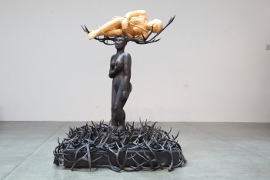 Describing the creator of the new exhibition STILL ..., on display from February 9 through April 14 at the Figge Art Museum, the venue's executive director Tim Schiffer says that installation artist and sculptor Alison Saar "is kind of pushing the boundaries of what sculpture is." Clearly, Schiffer has a gift for understatement.
Describing the creator of the new exhibition STILL ..., on display from February 9 through April 14 at the Figge Art Museum, the venue's executive director Tim Schiffer says that installation artist and sculptor Alison Saar "is kind of pushing the boundaries of what sculpture is." Clearly, Schiffer has a gift for understatement.
In Saar's exhibit piece titled 50 Proof, a vintage washstand sits below a glass bust of a human head, from whose eye sockets flows a continuous stream of black tears. In Black Lightning, a red fluid signifying blood is pumped, through copper tubing, from a bucket on the floor into a pair of boxing gloves on the wall. And in Rouse, a nude figure stands amidst a healthy assemblage of deer antlers, and cradles over her head another nude figure resting in deer antlers.
Well, make that antler sheds, as Saar is quick to say, "No animals were harmed in the making of this piece of art." She laughs. "I don't want PETA in there setting it all on fire."
The Los Angeles-based artist explains, "CalArts [the California Institute of the Arts] had done a theatre production where they needed all these antlers. They ordered them from eBay or whatever. But they recycle all their materials after the productions end, and I wound up getting about 200 antler sheds from them. So for Rouse, what I did was I covered the antlers at the feet in graphite, so they look like they're cast in metal but don't weigh, like, five bajillion pounds. And the antlers on the head are cast bronze, but they're made from a combination of wax molds and actual antler sheds.
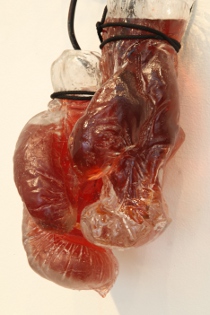 "My studio is floor-to-ceiling with materials like that," Saar continues. "And when I start cleaning up and going through them, then ideas start coming. Like, 'Oh, yeah! This could be something!' So I try to keep stuff around. It's the new, little things that can take you different places."
"My studio is floor-to-ceiling with materials like that," Saar continues. "And when I start cleaning up and going through them, then ideas start coming. Like, 'Oh, yeah! This could be something!' So I try to keep stuff around. It's the new, little things that can take you different places."
In the years since receiving her 1981 MFA degree from Los Angeles' Otis Parsons Institute (now known as Otis College of Art & Design), Saar has been a recipient of two fellowships from the National Endowment for the Arts and a 1989 recipient of the John Simon Guggenheim Memorial Foundation Fellowship, and has had residencies with Washington, DC's Washington Project for the Arts, New Mexico's Roswell Museum of Art, and New Hampshire's Dartmouth College. Her works, meanwhile, have been exhibited at such esteemed venues as the Metropolitan Museum of Art, the Whitney Museum of American Art, and the Santa Barbara Museum of Art, while Saar's public commissions have included the York statue for Portland's Lewis & Clark College and New York City's Harriet Tubman memorial statue Swing Low.
Among art critics, Art in America's Leah Ollman wrote that Saar's work is "so deeply informed by myth and history that its narratives become universal and inclusive." California-based art journalist Rebecca Epstein states that Saar's works "often embody a balance of strength and tenderness in form and idea," with her installation piece Suckle exuding "inherent grace." And the Los Angeles Times' Christopher Knight opined that the artist "means to invoke no less a precedent than Michelangelo for her own work ... [and] that Alison Saar does so - and that she manages to pull it off in a provocative way - is a testament to her considerable artistic skills."
With Alison Saar: STILL ..., which had its world-premiere showing at Otis in 2012, Figge guests will find themselves exploring numerous themes of vital interest to the exhibit's artist, among them racism, sexism, ageism, empty-nest syndrome, and the continued challenges of being bi-racial in America. The Figge's Schiffer adds that he believes the exhibition will be "completely accessible to the layperson. A lot of people don't know where to start with contemporary art. But a lot of her work is really rooted in personal experience, and I think that makes it more accessible, and gives people this kind of avenue of understanding."
Saar herself seems to hope so. "With a lot of my work, there are these really heavy sorts of ideas and issues. But I like to think there's always some element of play in them," she says with a laugh, "so I don't just scare everybody off."
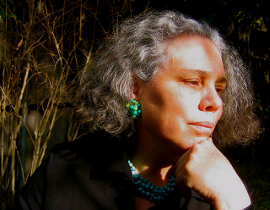 A Better Maker Than Writer
A Better Maker Than Writer
Born in Los Angeles in 1956, Saar had art practically encoded in her DNA: Her father Richard is an illustrator and art conservationist, and her mother Betye is a renowned artist known mostly for her assemblage and mixed-media works, among them her famed 1972 piece The Liberation of Aunt Jemima.
"A good portion of the day was dedicated to the [art] studio," says Saar of her upbringing in California's Laurel Canyon. "So a lot of what I learned was just by osmosis. Part of the studio was dedicated to my father's painting, and my mother was primarily a printmaker, but they always left a little corner for my two sisters and me to make messes and dabble in the arts.
"We were also at the museums constantly," she continues, "and we were in art classes when we were really young. And when we were really, really young, some of our early drawings made it into my mother's prints and assemblages, and we'd sometimes submit things to the Los Angeles County Art Fair and places like that, and sometimes pieces would sell for, like, $5, and you would just be so happy.
"But when I was maybe 12, I started making these little handmade dolls. They were dolls, but they all had specific histories, and they were about certain things, and their experiences would kind of form them as characters. That's where I became really interested in 3D work - doing three-dimensional stuff and figurative stuff. And so, curiously enough, I think those dolls really had a lot to do with the work that I do currently. My figures are very stoic and almost doll-like in the way they stand."
Saar adds that her interest in figurative art increased in high school, when she served as an assistant in her father's restoration business. "One of his big clients collected early-Chinese, Tang-dynasty works," she says, "so I'd spend part of my time cleaning frescoes. But he also had a client who collected African art, and I learned how to carve these reproductions, and that's really where I learned some of my more sculptural techniques."
Working alongside her father, she also developed a fascination for works from other cultures, one that deepened while Saar was earning her BA in studio art and art history from California's Scripps College.
"I became really interested in African art working with my father," says Saar. "And when I was taking a course in art of non-Western cultures, that included art from India and China and Japan, as well as South and Central America. So I was looking at all those things, and also became very interested in self-taught African-American artists, and discovering what things did and didn't carry over from African traditions. That's what I eventually did my [master's degree] thesis on: self-taught African-American artists."
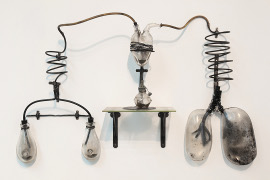 Saar planned to pursue a career as an art historian, "specifically the art of non-Western cultures. But I realized I was a better maker than a writer," she says with a laugh. "I had a senior thesis show, and I had gotten a really good response from that, and after I graduated and took a year off and traveled a little bit, I just decided that what I really wanted to do was make art. So I went to Otis a year after I'd gotten out of Scripps, for the MFA, and was just doing straight-up art from then on. "
Saar planned to pursue a career as an art historian, "specifically the art of non-Western cultures. But I realized I was a better maker than a writer," she says with a laugh. "I had a senior thesis show, and I had gotten a really good response from that, and after I graduated and took a year off and traveled a little bit, I just decided that what I really wanted to do was make art. So I went to Otis a year after I'd gotten out of Scripps, for the MFA, and was just doing straight-up art from then on. "
Asked if she was at all scared about embarking on a full-time career as a professional artist, Saar says, "Well, yeah. But I think if you have a parent who's done that, it's not so scary. I think my mother and father are both really good examples of how you can have a family and make art. Sometimes you have to do other jobs - my mother did costume design and all these other things as well as doing her art - and there were some lean times growing up, but it was always under control.
"I think what was scary was the thought of competing with them," she continues. "Specifically my mother. I think I was in high school when she got her first national endowment, and so I was kind of thinking, 'Will I ever get out from under her shadow?' That was more frightening than worrying about not being able to make it."
Following graduation from Otis, Saar spent two years employed at Los Angeles' Baum Silverman Gallery, which hosted the artist's first solo exhibition. "They showed contemporary Los Angeles artists as well as African art," says Saar, "so that was kind of a perfect match for me, and it went great.
"Of course, I already had an 'in' there because of my mother," she adds, referencing her mother's art-world celebrity. "And so I didn't really feel that I had made it all on my own, per se.
"But while it's good that doors are opened for you, because you have parents in the arts, at the same time people are always quick to slam you if you don't come up to snuff," says Saar with a laugh. "So it felt good to prove myself, and know that I could exist on my own ground."
And beginning in 1983, when she accepted a residency at the Studio Museum in New York - a city that the artist wound up living in for 15 years - Saar's sculptures and installations have gone to be shown in galleries, museums, and outdoor venues from coast to coast.
"It's a great feeling," says Saar, who adds with a laugh, "but you don't want to get cocky, because it can go away as easily as it came to you, you know? We artists are always holding our breath, but so far, I've been very, very fortunate."
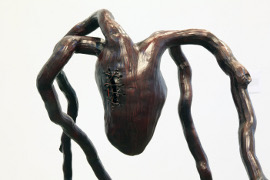 Quasi-Autobiographical
Quasi-Autobiographical
When I conducted my phone interview with Saar on January 21, the day in question was, of course, a rather momentous one, especially for someone of African-American descent. (Saar's father is white; her mother is half-black, half-white.) Not only was Barack Obama being inaugurated for his second term as president, but the event also happened to fall on Martin Luther King Jr. Day. And making the timing of our conversation even more appropriate, and ironic, was that President Obama's first inauguration actually served as the artist's initial inspiration for STILL ... .
"As African Americans," says Saar of the president's 2009 swearing-in ceremony, "there was a certain sense that, you know, we had arrived. But then all this backlash came with it, and all this racism percolated to the surface, and so, for me, it was all kind of bittersweet. You see that, yes, we've made these great advances, but at the same time, you realize that a good portion of the nation was still looking back, and still had some pretty horrific ideas about who could and could not be president.
"So I think that really kind of got me started with this show," she says of STILL ... . "Wanting to just try to understand what it takes to really understand the source of bigotry, and how bigotry can still thrive in this country that seems to be so progressive."
One piece in the STILL ... exhibit, titled Weight, is a visual representation of the exploitation and dehumanization of slaves, symbolized by Saar's figure of a young black girl on a swing dangling from a cotton scale, counterbalanced by items including an iron ladle, shackles, and a lock and key. Saar's Black Lightning considers the African-American male's stereotypical labor options, and high rate of violent death, in its boxing gloves that fill with makeshift blood. And questions of bi-racial identity, and the bigotry associated with it, are explored in 50 Proof, which Saar says reflects "this cultural myth of 'the tragic mulatto.'
"That one is kind of quasi-autobiographical," says Saar of 50 Proof. "My mother is also bi-racial, and was always trying to pass - trying to be as white as she could possibly be. From my generation, coming out of the Black Power movement and all that, I wanted to be recognized for my African-American ancestry. But there's this notion that we don't really belong in either camp - we're neither this nor that - and that came back to this notion of Obama. Initially, he wasn't black enough for the black community, and he certainly wasn't white enough for the white community; he kind of existed in this strange kind of in-between land.
"So the head of the [50 Proof] figure is invisible, it's glass, and when it fills up with this black fluid, you can see her. But you can't really see that blackness until her head is filled up with this black fluid, which cycles from this basin into her head and through her heart, and causes her to cry black tears."
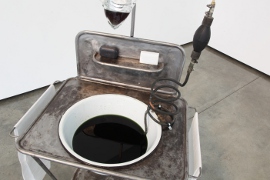 Yet racism is hardly the only theme explored in STILL ... . In Saar's Still Run Dry, a visual-art critique of sexism and ageism in America, glass, copper, steel, lead, and rubber are sculpted to resemble no-longer-functional female body parts placed on display and caked in dust. "I wanted it to speak to how there's still a lot of bigotry against women as they age," she says. "You know, the media always expects us to be young and beautiful and voluptuous and vivacious and all those things, and often, once we've reached a certain age, we're kind of pushed aside in society."
Yet racism is hardly the only theme explored in STILL ... . In Saar's Still Run Dry, a visual-art critique of sexism and ageism in America, glass, copper, steel, lead, and rubber are sculpted to resemble no-longer-functional female body parts placed on display and caked in dust. "I wanted it to speak to how there's still a lot of bigotry against women as they age," she says. "You know, the media always expects us to be young and beautiful and voluptuous and vivacious and all those things, and often, once we've reached a certain age, we're kind of pushed aside in society."
The antler-shed sculpture Rouse, says its creator, was inspired by Saar's daughter Maddy leaving for college, and the feelings her departure aroused in the artist. "The main figure has this sort of fierceness about her, and there's this sense of protection, and the figure that's resting in her horns is almost like a baby bird, or a vulnerable being that's still in its nest. It really kind of represented Maddy coming out as a young woman, and this sort of awakening in her.
"But at the same time," continues Saar, "both of those figures are kind of autobiographical for me. Because I kind of feel that there's a new self that's starting to come out who's no longer a mother, in the sense of my feeling that I have to watch and protect my children every step of the way. Like there's a new self being born in the process, as well. So that smaller figure is, in a way, both myself and Maddy at the same time."
And in a completely different visual vein, the three cast-bronze figures that compose Saar's Hankerin' Heart sculptures - playfully named Hincty, Mosey, and Gimpy - are human hearts with long, lanky tendrils that wouldn't look out of place in a stop-motion-animated movie by Tim Burton. ("I get that," replies Saar when I reference Burton. "People also mention that they're very Louise Bourgeois, because she did all those giant, beautiful spiders.")
"As adults and as partners," says Saar of her trio of Hankerin' Heart sculptures, "we kind of carry this baggage of our past experiences and loves. And try as hard as we may, if we've been scarred or wounded, we proceed into our next relationships with our defenses up. We're not always able to be as open and generous as we perhaps were in our first relationships, because we've been burned.
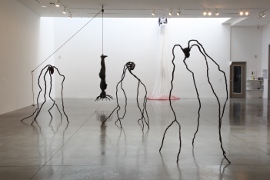 "So those figures are kind of like these three little hearts. Hincty, the one up front, is kind of tightly wound, and she's being pursued by Mosey and Gimpy - one has these lumps of what look like stab marks, and the other one has this gash that's been roughly sutured back together. I wanted to create these little hearts that are sort of their own little animal selves, and that go on even when they feel vulnerable or exposed or susceptible; they're kind of silly and kind of goofy, but I think they have this sort of dark undertone."
"So those figures are kind of like these three little hearts. Hincty, the one up front, is kind of tightly wound, and she's being pursued by Mosey and Gimpy - one has these lumps of what look like stab marks, and the other one has this gash that's been roughly sutured back together. I wanted to create these little hearts that are sort of their own little animal selves, and that go on even when they feel vulnerable or exposed or susceptible; they're kind of silly and kind of goofy, but I think they have this sort of dark undertone."
Assessing the combined 13 works in her Alison Saar: STILL ... exhibit, the artist says, "I just never really know where my inspiration will come from. Usually it just has something to do with how I'm feeling, you know, and reflects what I'm going through personally. And all I can hope is that it opens up a little bit of dialogue. I like that young kids can come experience it, and old people can come see it, and hopefully there can be some sort of exchange between the two. I think that would be great."
As for whether she has favorite individual pieces amongst her decades of creations, Saar says, "I don't know. I remember I had a show about three or four years ago - it was kind of like a retrospective - and there were pieces that were some of my earliest works, and there were works from like 10 years ago, and to see them all in this room together, it felt like seeing the big siblings with the little siblings.
"For me, they kind of have a life of their own - they go out, and they get moved around, and they've probably been more places than I have," says Saar with a laugh. "And because different people bring different things to them, I feel like they kind of grow in a weird sort of way. So I guess they are kind of like kids. And it's always nice to visit them."
Alison Saar: STILL ... is on display at the Figge Art Museum from February 9 through April 14, and the artist will discuss her works at a special Figge presentation at 2:30 p.m. on Saturday, February 9. For more information on the exhibition, call (563)326-7804 or visit FiggeArtMuseum.org.








